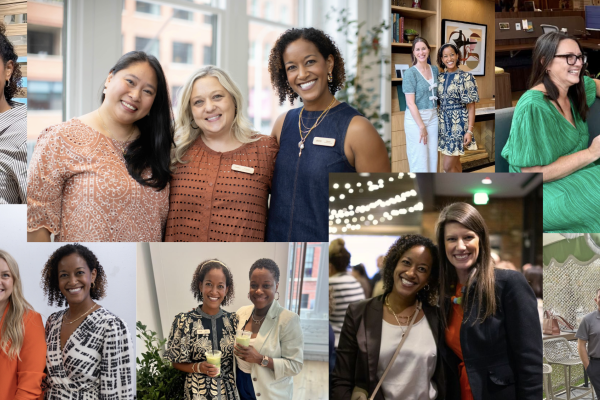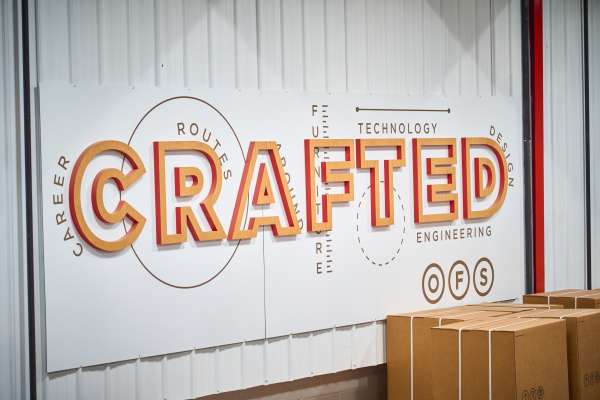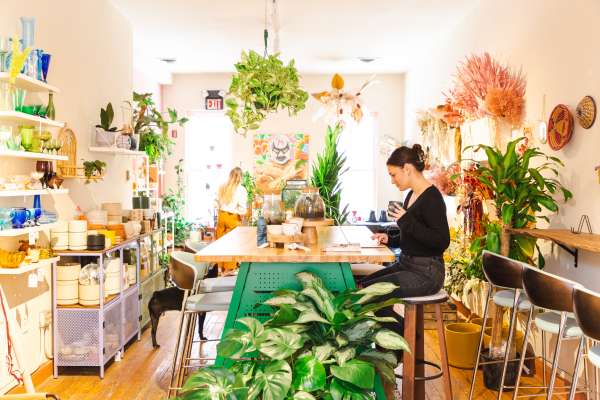At his home in Atlanta, Georgia, Chris Heard, principal at Hendrick Inc., a 47-year-old commercial interior design firm, shares his journey on becoming an architect and designer.
How positive thinking builds resilience
Many people in the 1960s might have described rural Alabama as a place of unrest, with Birmingham being one of the most segregated cities in the United States. It’s difficult to imagine what it might have been like as a Black child watching some of our history’s most influential civil rights activists and movements unfold only hours from your hometown. But despite the negativity and unrest at the time in Smiths Station, Alabama, Chris Heard grew up in a household and community he describes as joyful, with a strong belief that you could change your world and people’s perceptions about you if you set your mind to it.
Chris’ mother was a steady force of positivity and encouragement for him and his two younger brothers, “When I came home with a good grade, she would say ‘you’re as smart as anybody else and can do what anybody else can do,’” Chris remembers. “She was always sharing our accomplishments with her friends. It was this way of protecting you, but also letting you grow.”
For Chris, the community was captured best at church on Sundays, where friends and neighbors, who felt more like family, came together under one roof. Having attended a segregated elementary school and then later an integrated middle school, the community became vital in helping Chris feel a sense of comfort. “We all clung to each other in a way because it made us feel secure,” Chris says. “As a kid, when you have mean things thrown at you every day, and just the negativity and the name-calling, it could be pretty scary. So you find comfort in your home and family, and encouragement from people saying, ‘hang in there, you’re going to be fine.’”
When children are nurtured at home and in their community, positive thinking becomes a powerful tool for building resilience. For Chris, the joy and encouragement he received from his family and friends in his community granted him the freedom to step out of a self-protective mode and be a kid.
Designing a feeling more than a place
Though it didn’t feel like it at the time, Chris realizes now that his family didn’t have a lot. He remembers being in sixth grade when they finally had a bathroom added to their house, which up until then had been an outhouse. “I loved watching the framing go up,” he remembers. “One day I went in, and they had added a window, but it was right where the shower was, and I knew it would get wet. I went to my mom and said, ‘I think we need to move the window, so it doesn’t rot out from the water.’” As he reflects, Chris identifies this moment as his first architectural decision.
Throughout his education, Chris recognized that while he was good at math and science, he was also a visual learner and excelled in drawing classes. His desire to conceptualize and build grew alongside the growing suburbs of Smiths Station. “If a new house was going up close enough to where I lived, I would walk over after the construction crew left to look at things and walk through the plans—I would also steal nails so that I could build forts in the woods,” Chris laughs.
Every year the woods surrounding Chris’ home would bloom prolifically with a canopy of pink and white azalea flowers. It’s here that he and his brothers would take their “borrowed” nails and build their forts to escape to. While 50 years have passed since then, the memories and place are forever imprinted in his mind, “It’s amazing what those images can do and how strong their influence can be. The idea that, while you can’t recreate that, you can create a place that gives you those feelings again,” he shares.
A breakthrough moment was an assignment that came his junior year in high school. Each student was tasked with writing a biography on a famous American. Chris chose Frank Lloyd Wright. “Looking at his work, from the Usonian house to the Marin County Civic Center, I saw that you could build something playful in its own way. That idea really fascinated me and ultimately led me to architecture as a career option,” Chris explains.
The link between architecture and feelings or memories is much easier to sense than it is to explain. Understanding this intangible element of placemaking and the desire to create buildings and environments that evoke certain emotions has inspired Chris throughout his career.
The people who move us forward in life
Following high school, Chris attended Auburn University, where he studied architecture. During his first few years of college, he was the only Black student in his department. While the situation provided its challenges, Chris was encouraged by peers and professors who gave him the hope he needed to overcome adversities.
One of the most important relationships Chris formed was with Betty Finley, the advisor for the school of architecture. Chris walked into her office one day after being placed in a class with a professor who was widely known as a racist. “She looked at my schedule and said, ‘don’t say another word,’ and immediately switched me to a different studio,” Chris notes. “Then she looked me in the eye and told me, ‘You need to have a level playing field because it’s going to be an uphill battle for you, and I want you to succeed.’” Betty took on a similar role of encouragement like that of Chris’ childhood community. Her support and desire to see him thrive were central to his ability to overcome adversity.
Chris’ determination to become an architect was first motivated by his passion for the profession, but as he advanced in his education, what his success represented took on greater meaning. “Anybody who gets an architecture education knows you’re in the building all hours of the night working,” Chris recalls. “Two of the janitorial staff were Black gentlemen who had been working in that part of the building for a long time. They started to engage with me, asking me about my studies. One night, they gave me 50 bucks out of their own pockets. I said, ‘I can’t take this.’ And they said, ‘No, you will take this because we are so proud of you.’” At that moment, Chris understood the weight of his success and what that meant and represented for others. He remembers being overwhelmed, but also incredibly encouraged by the support of those who believed in him.
As Chris finished his education and moved into his career as a commercial architect, his community continued to expand and change with him. Just as it was during his youth, the significance of community and the feeling that you are cared for by those around you gave him the courage to trust in himself and pursue his dream.
A place that feels like you
Chris first moved to Atlanta in 1985. In 1989, he recalls walking through the neighborhood of Ansley Park with his friends. In awe of the beautiful historic homes, he desired to live there one day. Fast forward 36 years: Chris has not only achieved this goal, but many more.
In 2017, Chris purchased a house in Ansley Park, hired his friend who is a residential architect, and began renovating. He attests that it has been a long process and a true labor of love, but it pleases him to know that the completed house has become a home with so much more. “As you walk through the front door, you see a photograph of my mother—the matriarch of the home. For me, that’s communicating to people the importance I feel toward making connections with family and friends. A home is for connection, for fun, and for welcoming others and creating memories with the people you love, so I designed this home with community in mind,” Chris smiles.
When his friends and family first walked through the house, they told him, “This place feels like you.” For Chris, there is no greater compliment. The idea that a place can embody a person, and their presence can be felt in that space is what a home is all about. For Chris, home has always been where memories are made, laughter is shared, and more than that, where you feel loved, respected, and cared for.
There is no one meaning for the word home. It encompasses a place, memories, and feelings. Though every home is complex and multifaceted in its own way, there’s a reason people say, “Home is where the heart is.” We all move and live in different places throughout our lives, but home is where we feel the deepest affection to family and friends, no matter where we choose to plant our roots.
Have patience in the face of adversity
When we asked Chris what his advice was for young designers and architects today, he simply stated, “patience.” When it comes to morality, patience is a quiet trait. It’s not an outward or easily observed one, but for Chris, it’s central to who he is as a person.
“The pace of media today is so immediate that people expect things to happen overnight. But building a career takes time. It’s a path to gaining experience and learning how to communicate and connect. It literally took me 30–plus years to get here,” Chris laughs. “Hard work and patience rewarded me with becoming a partner in the firm in 2008.”
Having patience taught Chris to understand his value, which in time he was rewarded for in his career. “It’s going to be frustrating at times, but that’s just the nature of living,” he comments. “Have respect for the process and the work, and just relax and enjoy the journey. It will make you a more well-rounded person.”
Two sides of the same coin
The events of 2020 have caused the world to wake up and face several deep-seated problems in our country. For the Black and Asian American communities in particular, it’s been challenging to watch the animosity toward race become so prevalent.
“When the incidents with George Floyd and Breonna Taylor occurred, as an African American, it took me back to a place I thought we had moved past,” Chris shares. “Every minority knows that things aren’t just exponentially better, but there has been more tolerance”. Chris continues, “Yet, when things like this happen there is this underlying beast, if you will, that’s still very much alive, and you can’t help but go, ‘Oh my God, I prayed that things like this would never happen again, but here they are.’”
He describes the lack of compassion in the events of 2020 as heartbreaking. But Chris’ mother raised him to see a brighter, better future, and so he does. He understands that social justice is the impetus for compassion and that they are two sides of the same coin. As he has moved into the established years of his career, he sees a need to educate younger designers to be informed, aware, and empathetic, and believes achieving this is a step toward creating a society where both diversity and justice prevail.
“Diversifying my industry starts with getting kids interested in architecture and design as not only a profession but a way to succeed,” Chris said. “It’s going to take an investment of time and presence, not just from presentations, but from sitting down and having a conversation and dialogue with them.”
When he looks at the success he has had in his own life and career, he thinks of his mentors. The people in his life—from his mother to Betty Finley—who have played a critical role in his development. “It’s ironic, but the name of the church I grew up in was, ‘Good Hope,’ Chris explains. “Today, I’m hopeful that I can provide an influence on someone that will have a huge impact on their life. And despite current events, I’m optimistic about the future, and I hope to play a role in helping everyone be better in the way we treat each other.”

















